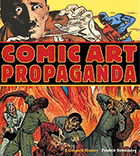
 Even the most cursory look at Comic Art Propaganda overwhelms the eye with a dazzling array of painting, drawing, caricature and cartooning. Closer examination of the artwork shows how brilliant use of color and graphics pumps up the energy and/or outrage for that special brand of storytelling that makes comics so popular in the U.S., Belgium, France and Japan. "Comics have been used time and time again as tools of propaganda... because [they] have an almost magical way of catching and keeping the reader's attention," Strömberg says at the beginning of his fascinating survey of 20th-century comics intent on promoting agendas, both wild and prosaic.
Even the most cursory look at Comic Art Propaganda overwhelms the eye with a dazzling array of painting, drawing, caricature and cartooning. Closer examination of the artwork shows how brilliant use of color and graphics pumps up the energy and/or outrage for that special brand of storytelling that makes comics so popular in the U.S., Belgium, France and Japan. "Comics have been used time and time again as tools of propaganda... because [they] have an almost magical way of catching and keeping the reader's attention," Strömberg says at the beginning of his fascinating survey of 20th-century comics intent on promoting agendas, both wild and prosaic.
Strömberg divides his history by the major themes he finds, including inciting racism, supporting wars in progress and promoting certain religions. Although his approach is balanced and almost scholarly, reading about the comics themselves, as well as their large audience, reminds how easily fear can be exploited to promote insularity and hatred. One particularly disturbing section concerns comics that grew out of "the Asian question" (initially, fear of the potential volume of Chinese immigration into the U.S.) with their tone of "downright racist, derogatory hate-based propaganda." The comics that came out of the 1950s Red Hunt in the U.S. are equally telling on that score.
Strömberg devotes well-deserved time and attention to La bête est morte! (The Beast Is Dead), a retelling of the history of World War II, and to Art Spiegelman's Maus, his intensely personal attempt to deal with the Holocaust. Strömberg celebrates their status as deft and affecting works that make the complexities of history vivid and absorbable at the same time that he looks at them as "propaganda."
As Strömberg recounts, Petr Sadecky took another approach to history in his Octobriana and the Russian Underground. Sadecky has said that he went to Russia in the late 1960s and met a group of dissident artists calling themselves the Progressive Political Pornography group. Their main creation was Octobriana, an angrier and more dangerous variant of Brigitte Bardot. Sadecky smuggled copies of the underground comics featuring Octobriana back to Czechoslovakia and published his story to acclaim and much publicity in 1971. And then the story acquired a bizarre edge: upon closer examination, there seems to have been no Progressive Political Pornography group and nobody in Russia seems to have heard of Octobriana (the purported idol of all dissident youth); Sadecky may have engineered Octobriana himself--in one fell swoop, Sadecky's gambit proved that comics can be fun, subversive and completely misleading to uncritical readers. Beautiful propaganda and beautiful art!--John McFarland
Shelf Talker: A provocative, beautiful and disturbing survey of the role of comics (and their eye-popping art) in 20th-century propaganda.

